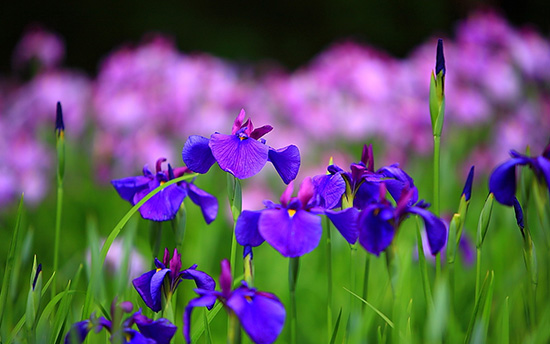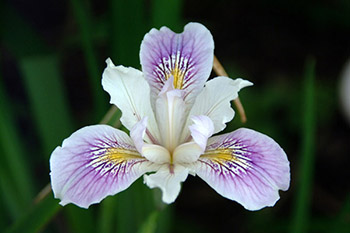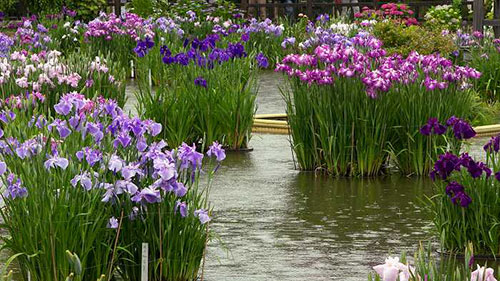Taking an environmentally sensitive approach to pest management
Iris: A Brief History
Published: June 4, 2014
According to Greek mythology, when the gods wanted to communicate with mortals on earth they sent a messenger. The messenger was a goddess who, with golden wings, traveled to earth on a rainbow. Legend has it that wherever this goddess set foot on earth, colorful flowers sprung up. The goddess in question was Iris, and the flowers that were said to grow where she set foot bear her name.
In spite of the fallacious nature of the above, the fact is in the Greek language the word “iris” means rainbow. And, indeed, the flower bearing iris as a name can be found in nearly every color of the rainbow.

The genus Iris is a member of the Iridaceae family and contains nearly 300 species. Most species of iris (also is its common name) are perennial plants growing on creeping rhizomes and producing showy flowers. Additionally, there are numerous inter-specific iris hybrids which adds to the complexity iris taxonomy.
The use of iris as a garden plant dates back to 1469 B.C. and King Thutmose III of Egypt. Apparently, the king was an avid gardener and coveted plants the way many at the time coveted gold. When Egypt conquered Syria, the king found irises growing in abundance and introduced them to his gardens. Iris soon became very popular and was regarded by Egyptians to symbolize both the essence and renewal of life. The three petals of the flower were thought to stand for faith, wisdom and valor. Its rhizomes were used for medical purposes and for the manufacture of perfumes and incense used in religious ceremonies.

Iris is a monocot whose flowers are in parts of three. Its three sepals droop downward and are referred to as “falls”, while its three petals are exerted more upright and are known as “standards”. The shape of the iris flower was the inspiration for the “fleur-de-lis” emblem. In the Christian world, the fleur-de-lis came to be particularly associated with the Virgin Mary and purity. It was adapted by the powerful ruler Frankish King Clovis I in 500 A.D., following his conversion to Christianity. Throughout the ages, this emblem was widely used in heraldry and still can be seen today in architecture and other venues where symbolism is common. For example, the Boy Scouts symbol has the fleur-de-lis as its basis.
Irises made their way to New World as European settlers arrived. Early records indicate irises were planted in Virginia in the 1600s. The first great American iris enthusiast was Michael Foster (1836-1907). Foster was a physician and professor of human physiology who (somehow) found time to garden. He was succeeded by a young protégé of his by the name of William R. Dykes (1877-1925) who greatly advanced the study of iris taxonomy. The culmination of his work resulted in his 1913 publication The Genus Iris. In honor of the contribution made by Dykes, the top award that can be given to an iris bears his name: The Dykes Medal.
The most popular garden iris today is the German or bearded iris (Iris germanica). The common name is derived from the thick, bushy “beards” that appear on each of the falls of the flower. This species has been so widely hybridized that many cultivars are no longer morphologically typical of the original German iris. Thus, Iris ‘Bearded Hybrids’ often is listed today as its scientific name.
The American Iris Society recognizes six different classes of bearded iris, based mainly on plant size and flower morphology. The tall bearded class probably is the most popular and widely planted of the group. By careful selection of bearded irises, one can enjoy a remarkable range of colors and a bloom season extending for months. Some bearded irises blooming again in the summer or fall and are classified as “rebloomers”.
Most species of iris (included bearded) are relatively easy to grow. They require at least six to eight hours of direct sun and a well-drained garden loam. Tight, heavy soils should be amended with organic matter to improve drainage. Although an iris can be transplanted any time one can get a shovel into the soil (i.e. the ground is not frozen) late August through mid-October is best for our latitude.
Iris is propagated vegetatively through the division of fleshy rhizomes which have at least one growing point (fan) attached. It is important to plant iris at a depth that allows the top of the rhizome to be exposed to the sun. Spacing iris between 12 to 24 inches apart is the norm. Closer planting will a more results in immediate effect, faster clump formation, and more color. However, the clump will need rejuvenation (division) in two to three years.
Water newly-planted rhizomes immediately. Once established, irises can be watered less frequently. Watering frequency will depends greatly on their environment. It should be noted that over watering of irises is a common mistake. Whenever water is needed, less frequent deep watering is better than frequent, shallow watering.
Irises are fairly heavy feeders; therefore proper fertilization is important. Soil type and native fertility largely will determine fertilizer needs. When fertilizer is added, use a well-balanced fertilizer (e.g. 13-13-13 or 5-10-10). Fertilizers high in nitrogen should be avoided since excessive nitrogen encourages soft, vegetative growth more susceptible to diseases. Generally, a light application of fertilizer in early spring and again a month after bloom is sufficient. When applying fertilizer, take care not to place any directly on the exposed rhizomes.

Japaneese Iris
Irises are susceptible to a number of insect pests, the most troublesome being the iris borer. The latter is a moth whose larvae feed on the fleshy rhizomes. This, in turn, allows for the entry of bacterial soft rot which can quickly kill the rhizome. Inspect plantings frequently and discard infested plants. Additional insect pests include bud moth, iris weevil, thrips, and slugs and snails.
Common diseases of iris include bacterial leaf blight (spot), fungal leaf spot, bacterial soft rot and fungal crown rot. Good sanitation, keeping the garden free of debris and planting to encourage good air circulation all help in lessening disease occurrence.
When irises decline in the number of blooms produced it a signal the clump needs to be divided. Under normal conditions, this should be done every three to four years. One can either thin the clump by removing several divisions (leaving a portion of the clump in the ground), or remove the entire clump, improve the soil and replant a few large rhizomes.
A discussion of iris would be incomplete without the mention of Siberian iris (Iris siberica) and Japanese iris (Iris ensata). Siberian iris bears smaller blooms and has relatively narrow foliage. It prefers cooler temperatures and a slightly acid soil. Available in a variety of bloom colors, Siberian iris grows two to four feet in height. Bloom date is several weeks later than bearded iris.
Japanese iris has been hybridized for over 500 years and bears some of the most exquisite, showy flowers in the genus Iris. It prefers slightly acidic soil and demands adequate soil moisture. Wet in the spring and moist in the summer is a good rule for Japanese iris. Japanese iris blooms about a month after bearded iris.
Subscribe to receive similar articles sent directly to your inbox!
- 2024 All-American Program Selections (01/19/24)
- Sedum: The Ultimate Low-Maintenance Plant (09/25/23)
- Wildflowers for Summer Garden Color (07/10/23)
REVISED: September 29, 2015